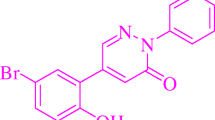Abstract
Inclusion complex of naphthalene with methyl-beta-cyclodextrin in water has been formed. The aqueous solutions of the various amounts of Co2+ve Mn2+salts have been added to naphthalene-methyl-beta-cyclodextrin (NAP-Me-β-CD) inclusion complexes. Fluorescence properties of the naphthalene (NAP) compound have been utilized to observe the changes in fluorescence intensities. Stern-Volmer quenching constants and fluorescence quantum yields have been calculated. Characterization of the resulting complex by FT-IR and 1H NMR technique has been determined. Fluorescence lifetime measurements have been made in the presence and absence of the quenching reagent and Gibbs free energy change has been calculated.










Similar content being viewed by others
References
Murugan M, Anitha A, Sivakumar K, Rajamohan R (2018) Supramolecular interaction of primaquine with native β-cyclodextrin. J Solut Chem 47:906–929
Norkus E (2009) Metal ion complexes with native cyclodextrins, an overview. J Incl Phenom Macrocyl Chem 65:237–248
Li S, Purdy WC (1992) Cyclodextrins and their applications in analytical chemistry. Chem Rev 92:1457–1470
Ehsan S, Prasher SO, Marshall WD (2007) Simultaneous mobilization of heavy metals and polychlorinated biphenyl (PCB) compounds from soil with cyclodextrin and EDTA in admixture. Chemosphere 68:150–158
Ay U, Dogruyol Z, Arsu N (2014) The effect of heavy metals on the anthracene-me- β-cyclodextrin host-guest inclusion complexes. Supramol Chem 26:66–70
Evans CH, Partyka M, Van Stam J (2000) Napthlene complexation by β-Cyclodextrin: influence of added short chain branched and linear alcohols. J Incl Phenom Macrocycl Chem 38: 381–396
Abdel-Shafi AA (2007) Spectroscopic studies on the inclusion complex of 2-naphthol-6-sulfonate with β-Cyclodextrin. Spectrochim Acta A 66:732–738
Mukhopadhyay M, Banerjee D, Koll A, Mandal A, Filarowski A, Fitzmaurice D, Das R, Mukherje SJ (2005) Excited state intermolecular proton transfer and gaging of salicylidine-3,4,7-methyl amine in cyclodextrins. Photochem Photobiol A Chem 175:94–99
Balta DK, Arsu N (2008) Host/guest complex of β-cyclodextrin/5-thia pentacene-14-one for photoinitiated polymerization of acrylamide in water. J Photochem Photobiol A Chem 200:377–380
López-de-Luzuriaga n JM, Monge M, Elena Olmos M, Pascual D (2014) Analysis of fluorescence quenching of naphthalene by two mercury containing organometallic complexes. J Lumin 154:322–327
Nouhi A, Hajjoul H, Redon R, Gagne JP, Mounier S (2018) Time resolved laser fluorescence spectroscopy of organic ligands by europium: fluorescence quenching and lifetime properties. Spectrochim Acta A 193:219–225
Yang H, Ran G, Yan J, Zhang H, Hu X (2018) A sensitive fluorescence quenching method for the detection of tartrazine with acriflavine in soft drinks. Luminescence 33:349–355
Jenne EA (1998) Adsorption of metals by geomedia variables, mechanisms, and model applications. Academic press (http://www.apnet.com)
Stanculescu I, Dobrica I, Mandravel C, Mindrila G (2010) FTIR and molecular modeling study of the interaction between β-Cyclorextrin and polychlorobiphenyls. Analele Universităti din Bucuresti – Chimie (serienouă) 19:47–52
Drössler P, Holzer W, Penzkofer A, Hegemannb P (2003) Fluorescence quenching of riboflavin in aqueous solution by methionin and cystein. Chem Phys 286:409–420
Wu A, Shen X, Gao HJ (2007) Investigation on photophysical properties of a substituted 3H-indole- modified β-cyclodextrin-II, efficient photoinduced energy transfer with naphthalene and its derivatives. Photochem Photobiol A Chem 185:144–149
Baggott JE, Pilling MJ (1980) Temperature dependence of excited-state-electron-transfer reactions, quenching of RuL3 2+ emission cupper (II) and euripum (III) in aqueous solution. J Phys Chem 84:3012–3019
Acknowledgements
As the authors, we would like to thank to Scientific Research Coordinaton Unit (BAP) of Kocaeli University (Project No: 2017/010) for their contribution to this study, and to the Department of Chemistry of Gebze Technical University for their assistance in measurements of the fluorescence lifetime. We thank TUBITAK (UME) for their assistance in measurements of 1H NMR.
Author information
Authors and Affiliations
Corresponding author
Rights and permissions
About this article
Cite this article
Ay, U., Sarlı, S.E. Investigation by Fluorescence Technique of the Quenching Effect of Co2+ and Mn2+ Transition Metals, on Naphthalene-Methyl-Beta-Cyclodextrin Host-Guest Inclusion Complex. J Fluoresc 28, 1371–1378 (2018). https://doi.org/10.1007/s10895-018-2301-9
Received:
Accepted:
Published:
Issue Date:
DOI: https://doi.org/10.1007/s10895-018-2301-9




